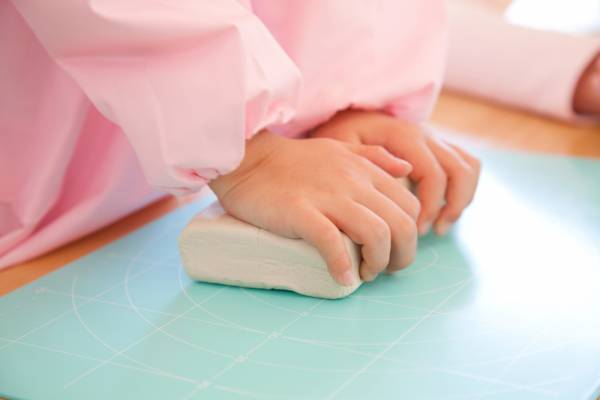Enouraging fine motor control is a critical part of raising children. Not only is fine motor control essential to daily life, but when it comes to sports, fine motor control is paramount.
Just a fraction of an inch difference in finger placement and release of a curveball can make the difference between a Major League pitcher, a decent high school pitcher, and a Friday Night Beer League player.
But how do we encourage the development of fine motor control, especially when so much of it is task specific? Here are three ideas for simplifying fine motor development in kids, inspired by the Montessori approach to learning and skill acquisition.
1. Provide Materials
Whether we’re talking about fat crayons, oversized buttons and buttonholes, or “comfort grip” utensils, the whole market for overly thick, oversized children’s materials actually discourages the development of fine motor control.
The Montessori system has the opposite approach. Pencils are of normal size, or even of smaller than average size if possible. Eating utensils are also smaller than adult utensils. The use of small items means the materials fit into children’s hands in a similar manner to how we expect them to fit into our hands as adults. With these tools, children can learn the motor patterns and muscular control that allow them to have fine motor control of the full-sized items later on.
“The Montessori idea of realism ensures you will use the most effective and age-appropriate tools to develop basic skills and also improve fine motor control.”
You can apply the same ideas for athletics. Youth basketballs are normally smaller sized than their adult equivalents. To encourage fine motor skill development in sports, use youth footballs, soccer balls, and other sports equipment that are similarly scaled down.
RELATED: Inexpensive, Easy Ways to Prepare the Fitness Environment for Kids
2. Repetition
Much of fine motor control is actually unconscious. We don’t think about each individual curve and line as we sign a document, because the appropriate level of fine motor control has been so established that signing a paper has become an unconscious act.

Bruce Lee commented on this level of skill in his discussion of the three phases of learning martial arts.
- A punch is just a punch. While usually thrown with little skill and bad mechanics, the action is natural and unconscious.
- The conscious skill phase, when a punch becomes more than a punch. The martial artist is consciously thinking about hand placement, targeting, and body control. While the mechanics and technique might be better than they were in the first phase, there is often a robotic quality to the actions, and they rarely flow.
- A punch becomes just a punch, but now it is technically and mechanically sound.
This idea goes beyond the sphere of martial arts. The same idea applies for children and their fine motor skills. Encouraging repetition, as much as the child wants and can handle, will ingrain the motor patterns and fine motor control needed for later performance of the skills in game situations.
LEARN MORE: 4 Training Lessons We Can Learn From Bruce Lee
3. Strengthen the Entire System
Developing overall strength will allow for greater fine motor control in kids. The basic premise is that the lower percentage of total muscular power needed to complete an action, the greater amount of motor control possible.
You see this in sports all the time. Pitchers are pulled from baseball games not when their fastballs are slowing down, but when their pitch placement gets wonky. Heavyweight boxing matches usually go from crisp, technical punches in the first few rounds to sweaty hug-fests by round ten. The rare occasions when players do display amazing examples of skill and motor control in the later stages of events are usually hailed as extraordinary.
“In general, the stronger and fitter the overall system is, the better fine motor control can be achieved.”
For sports that involve the use of the hands and forearms, there are numerous ways to develop strength. In Montessori classrooms, we often use clay in art projects. Students are encouraged to form, shape, and pinch the clay using just their fingers. They start with soft clay and work their way up to firm clay. While this activity is meant to develop strength for handwriting, it can also be used for developing the hand strength needed to throw a football.
Even for sports skills that involve other body parts and functions, the same principle can still apply. Building stronger legs gives basketball players that extra cushion for performing spin moves in the fourth quarter, and gives running backs the ability to cut more sharply late in the game. In general, the stronger and fitter the overall system is, the better fine motor control can be achieved.

Foundational Training Can Help
It is axiomatic that before a difficult skill is attempted, lower level skills must first be mastered. Figure skaters do not start doing triple toe loops without having first mastered turns, spins, and other basic skills.
LEARN MORE: Foundational Training for Youth Athletes: Are You Doing It?
Foundational training is slightly different, in that we take it down even one level more, building the most basic versions of the skills and doing them in a challenging way. While skills are diverse based on the needs of the goal activity, foundational skills exist regardless of the sport you play.
Foundational Training is built upon the idea that the body moves in certain planes and patterns consistently. Currently, I use eight different patterns in my foundational training teaching:
- Squat
- Hip Hinge
- Vertical Press
- Horizontal Press
- Horizontal Pull
- Vertical Pull
- Twist
- Abdominal Flexion
By training these basic foundational movements, you can build the systems for later basic skills training. The Montessori idea of realism ensures you will use the most effective and age-appropriate tools to develop basic skills and also improve fine motor control.
In the end, fine motor control remains an elusive subject. Coaches search for it, athletes treasure it, and trainers try everything they can to make it possible. Incorporate these hints into your own training and when working with your children, and watch the fine motor skills improve.
Photos courtesy of Shutterstock.






